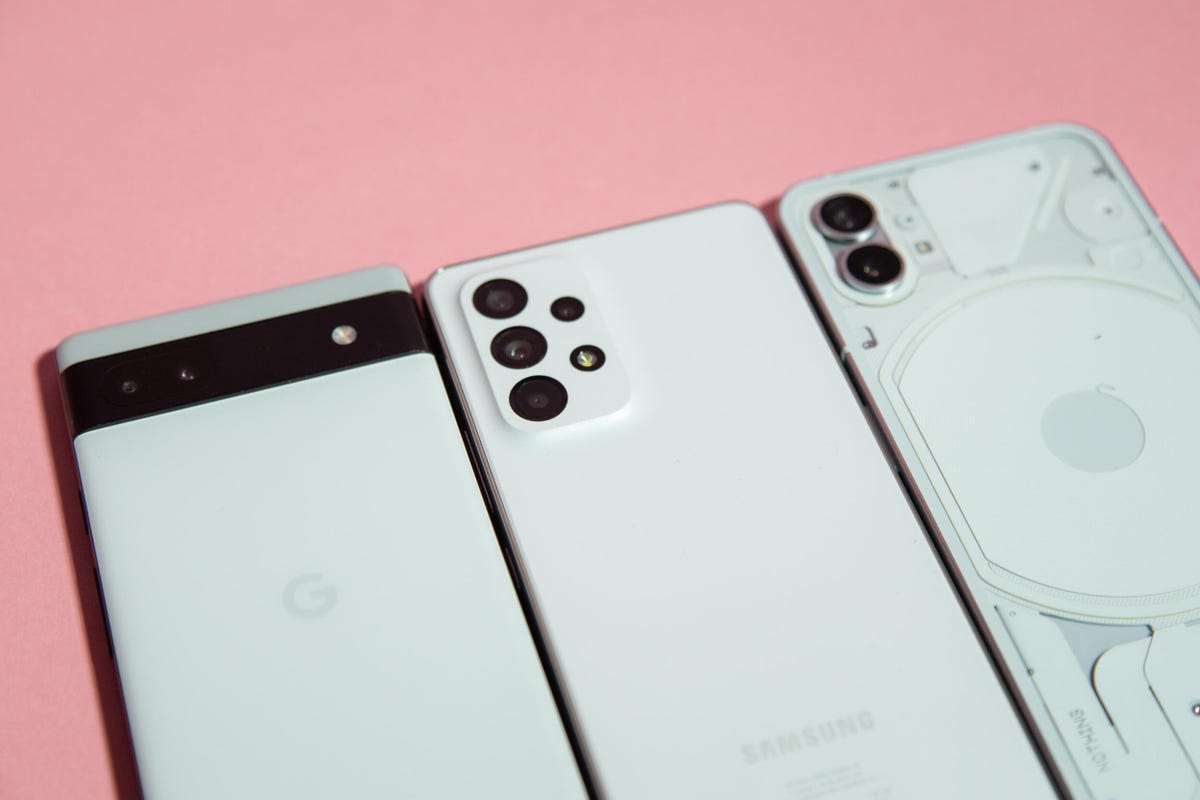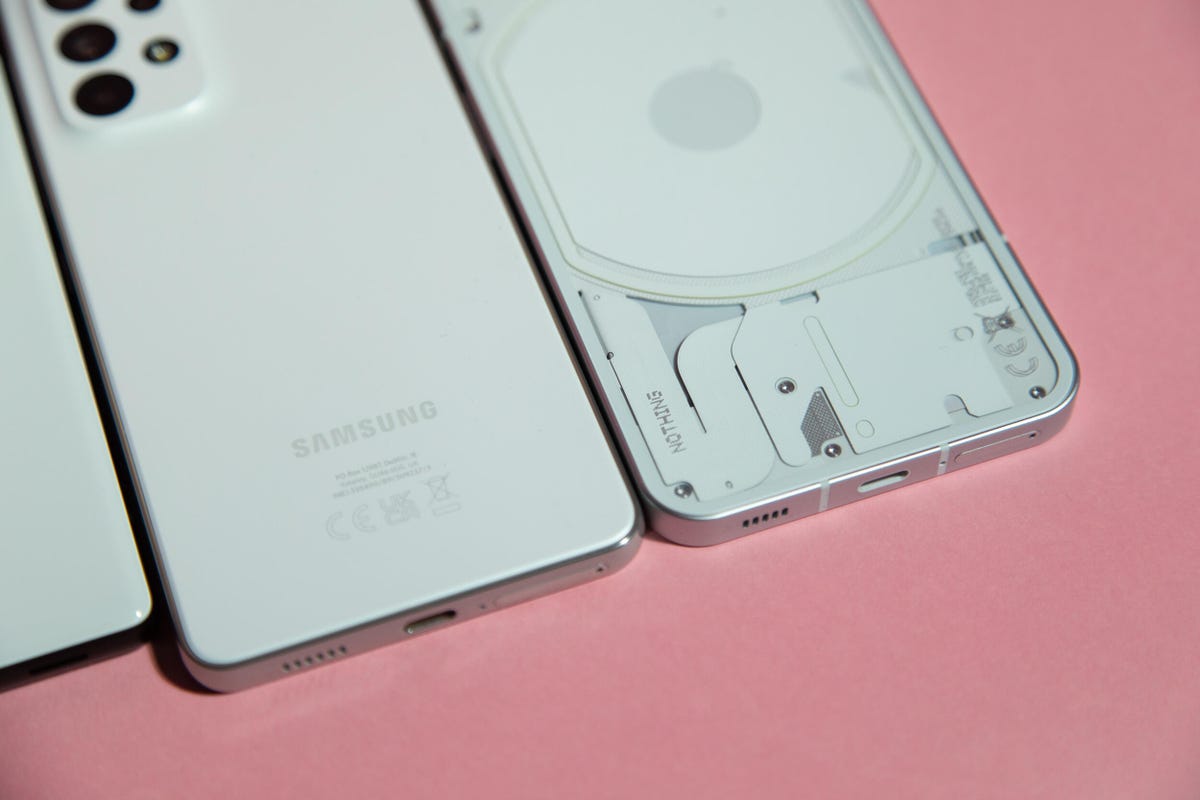Pixel 6A vs. Samsung Galaxy A53 vs. Nothing Phone: Under-$500 Phones Compared
Phones that cost just under $500 are looking better and better as 2022 continues, with Samsung, Google and new contender Nothing all offering three phones at pretty much identical $450 prices. All three of these phones promise a slick and enjoyable experience, even with their lower prices.
The Google Pixel 6A has already earned itself a glowing review, with CNET’s Lisa Eadicicco calling it “the best budget Pixel yet.” Meanwhile I myself was impressed with the Nothing Phone 1‘s balance of price and performance — not to mention its flashing rear lights. Then there’s the Samsung Galaxy A53 5G, which earned a great review score thanks to its price, its display and its cameras.
But which phone is actually deserving of your hard-earned cash? I got hold of all three to put them through their paces.
Andrew Lanxon/CNET
Price and availability: The Nothing Phone 1 is hard to get
Let’s start with a biggie. the Nothing Phone 1 is on sale in the UK and wider Europe but a rollout into the US is so far uncertain. While Nothing has said it would like to launch its phone in the US, it needs a network partner to make it compatible with US 5G networks. As of the time of writing, there are no plans for a proper US launch. People in the US can easily get the Pixel 6A and the Galaxy A53 5G, however.
All three phones start at very similar prices; $450 for the Pixel 6A, $450 for the Galaxy A53 and $472 for the Nothing Phone 1, based on a conversion from its UK price. In the UK, all three phones start at £399. Simple.
Design and display: Nothing’s flashing lights stand out
While many phones in recent years have been forgettable-looking slabs, all three of these midrangers have designs that are very much their own. The A53 keeps things simple with a plastic back, raised camera unit and metallic edging. The Pixel 6A maintains the distinctive camera bar seen on its pricier siblings and while its back is technically plastic, you’d be hard pressed to tell it apart from the glass back of the 6 and 6 Pro.

Andrew Lanxon/CNET
Between the two, the Pixel 6A has a more premium feel, than the plasticky A53, but it’s the Nothing Phone 1 that stands out in the looks department. That’s due to its transparent back panel, which not only provides a unique view of its internal components but also allows for its light-up LED “glyph” to pulse when you get notifications. It’s arguably a gimmick and one that you may not care about at all, but it’s certainly fun and it’s nice to have something quirky at this price.
The Pixel 6A is the smaller of the three, packing a 6.1-inch display against the Nothing’s 6.55-inch and the A53’s 6.5-inch screens. That said, the Pixel’s resolution results in a pixel density higher than its competitors, although all three are pin sharp with vibrant colors and high brightness levels. The Nothing’s extra size might make it the better choice for mobile gamers among you, or those of you who watch a lot of video on the move, but they all do a good job of displaying vibrant content and colorful games.
Power and performance: Pixel 6A packs a punch
The Nothing Phone 1 makes use of a Snapdragon 778G+ processor and 12GB of RAM (as reviewed), while the Galaxy A53 5G uses an Exynos 1280 chip and 6GB of RAM. The Pixel 6A meanwhile uses Google’s own custom-built Tensor processor with 6GB of RAM.
And that Tensor processor put in some excellent scores on our suite of benchmark tests, that put it consistently above the other two. The Nothing was a fair second, while the A53 did somewhat fall behind on both CPU and graphics benchmarks.
Performance comparison chart
Legend:
Geekbench 5 (Single core)
Geekbench 5 (Multi-core)
3DMark Slingshot Unlimited
Note:
Longer bars equal better performance
Benchmarks alone aren’t a perfect indicator of real-world performance however and I found all three to be perfectly capable of handling the essentials well. Navigating the interfaces was swift and lag-free on all models and all of them handled more demanding gaming in Asphalt 9: Legends without any noticeable stuttering or slow-down. Video streaming was no problem on any phone and I could immediately jump between open apps with the multitasking switcher.
Over time I would expect the Pixel 6A to generally perform better as it’s already starting from a more powerful position. It might mean that as even more demanding games arrive it’s well-placed to handle them in a way that perhaps the A53 couldn’t. Right now though, any of your everyday emailing, Instagramming, Candy Crushing, WhatsApp group message avoiding fun will be handled perfectly well by any of these phones.
Cameras: Pixel 6A strikes the right balance
All three phones have multiple rear cameras, giving both standard views and ultrawide shots. The A53 includes a 5-megapixel macro camera and a depth sensor for portrait photos, but it’s the main and wide cameras you’ll likely find yourself using most often. Samsung’s phone cameras have often had a tendency to look overly saturated and contrasty and that’s absolutely the case with the A53.

Galaxy A53 main camera test.
Andrew Lanxon/CNET

Nothing Phone 1 main camera test.
Andrew Lanxon/CNET

Pixel 6A main camera test.
Andrew Lanxon/CNET
Its shots are consistently punchy with the colors, to the point that they look as though you’ve slapped on some high-contrast filter on Instagram. The Nothing Phone 1 goes the other way, however, with frequently muted tones. It’s particularly noticeable when you switch to the Phone 1’s ultrawide lens, which produces drab-looking images that look almost shameful against the others.

Galaxy A53 ultrawide camera test.
Andrew Lanxon/CNET

Nothing Phone 1 ultrawide camera test.
Andrew Lanxon/CNET

Pixel 6A ultrawide camera test.
Andrew Lanxon/CNET
It’s the Pixel 6A that consistently produces the most balanced-looking images in both its standard and ultrawide views. The 6A’s colors are accurate and vibrant, without looking overly processed, and it generally captures a more balanced exposure than the other two, keeping bright skies under control well.

Galaxy A53 main camera test.
Andrew Lanxon/CNET

Nothing Phone 1 main camera test.
Andrew Lanxon/CNET

Pixel 6A main camera test.
Andrew Lanxon/CNET
All three phones are perfectly capable of taking decent snaps at your next family picnic, but if photography prowess is important to you then the Pixel 6A is the one to go for.
Battery life: A close fight but Pixel 6A takes the win
With a huge 5,000-mAh battery stuffed inside I expected the Galaxy A53 to put in the best performance when it came to battery life. It’s a more capacious cell than the 4,410 mAh of the Pixel 6A or the 4,500 mAh of the Nothing Phone 1. On my tests, however, it was the Pixel that managed to edge out the competition.
After 1 hour of streaming a YouTube video on Wi-Fi, with the screens set to maximum brightness, the Pixel had dropped from full to 98% remaining. The Nothing Phone 1 dropped to 95% in the same time, while the A53 dropped to 94%. After a second hour, the Pixel had dropped to 92%, with the Nothing phone coming in a close second at 90%, with the A53 having dropped to 89%.

Andrew Lanxon/CNET
Sure, the Pixel technically did the best here, but we’re really only talking a few percentage points between them, which isn’t a big deal. All three put in solid performances: Both here and in everyday use, the battery lift you can expect to see will vary depending on how much you demand of your phone.
With careful use you won’t struggle to get a full day out of any of the phones, and all three will likely want a full recharge every night.
Software and other features
All three phones run Android 12 at their core, but you will find some notable differences in the experience. The Pixel 6A runs a pure, Google-produced version of Android 12. It’s a clean and clutter-free experience that I’ve enjoyed using for some time on the Pixel 6 and 6 Pro. The Nothing Phone 1 has a visual skin that includes different colors, fonts and backgrounds, but it’s also neat and stripped-back, making it smooth and simple to navigate.
The A53 immediately annoyed me with a variety of prebundled apps, including ones for Booking.com, TikTok, Nextdoor and a variety of Samsung’s own apps and stores. These apps make the phone feel cluttered before you’ve even begun to install your own. There are two different messaging apps, for example — Google’s and Samsung’s — so Android novices might find it more complicated to get to grips with.

Andrew Lanxon/CNET
The A53 does have a killer feature not found on the other two though: expandable storage. While the Pixel 6A comes with 128GB of storage and the Nothing Phone 1 is available with up to 256GB, the Galaxy A53’s 128GB of storage can be expanded with microSD cards up to 1TB in size. That makes it a great option if you take a lot of photos or videos or want to save a lot of media locally to your phone to enjoy when you don’t have an internet connection.
Which phone should you buy?
The Nothing Phone 1’s unique design certainly gives it an edge over the others, but if you’re not bothered about those flashy lights, you love taking wide-angle photos on vacation — or if you live in the US and can’t even buy it — then you should look toward the others.
While the A53 5G performed admirably in our tests, it was the Pixel 6A that consistently came out on top. Its processor performance is better, it takes better photos from both its cameras, its pure Android interface is nicer to navigate and it even feels like the more premium device when you hold it.
The A53 is larger and its expandable storage gives it a definite one-up if you want to store a lot of media, but overall it’s the Pixel 6A that offers the best value for money.
Pixel 6A vs. Nothing Phone 1 vs. Galaxy A53 5G specs comparison chart
| Google Pixel 6A | Nothing Phone 1 | Samsung Galaxy A53 5G | |
|---|---|---|---|
| Display size, resolution | 6.1-inch OLED; (1080 x 2400); 60Hz | 6.55-inch OLED display, 2,400 x1080 pixels; | 6.5-inch AMOLED (2,400×1,080 pixels); 120 Hz |
| Pixel density | 429 ppi | 402ppi | 405ppi |
| Dimensions (Inches) | 6.0 x 2.8 x 0.35 in | 6.28 x 2.94 x 0.32 in | |
| Dimensions (Millimeters) | 152.2 x 7.18 x 8.9 mm | 159.2 x 75.8 x 8.3 mm | 159.6 x 74.8 x 8.1 mm |
| Weight (Ounces, Grams) | 6.3 oz; 178g | 193.5g | 6.67 oz; 189g |
| Mobile software | Android 12 | Android 12 | Android 12 |
| Camera | 12.2-megapixel (wide), 12-megapixel ultra wide) | 50-megapixel (main), 50-megapixel (ultrawide) | 64-megapixel (wide), 12-megapixel (ultrawide), 5-megapixel (macro), 5-megapixel (depth) |
| Front-facing camera | 8-megapixel | 16-megapixel | 32-megapixel |
| Video capture | 4K | 4K at 60fps | 4K |
| Processor | Google Tensor | Snapdragon 778G+ | Exynos 1280 |
| RAM/Storage | 6GB RAM/128GB storage | 8GB + 128GB, 8GB +256 GB, 12GB RAM + 256GB | 6GB/128GB |
| Expandable storage | None | None | Up to 1TB |
| Battery/Charger | 4,410 mAh capacity; 18-watt fast charging (adapter sold separately) | 4,500mAH (33W wired charging, 15W wireless charging, 5W reverse charging) | 5,000mAh (charger not included, does not support wireless charging) |
| Fingerprint sensor | Under display | In-display | In-display |
| Connector | USB C | USB-C | USB-C |
| Headphone jack | None | None | None |
| Special features | 5G-enabled, 18W fast charging, WiFi 6E, security updates for 5 years, Android OS updates for 3 years, dual SIM, IP67 water resistance | 5G, IP53, Three years of Android updates, Dual Sim, 120Hz adaptive refresh rate | 5G-enabled; IP67 rating; supports 25W wired fast charging, Samsung Pay |
| Price off-contract (USD) | $449 | $470 (converted) | $450 |
| Price (GBP) | £399 | £399 | £399 |
| Price (AUD) | A$749 | AU$685 (converted) | AU$699 |



